| Listing 1 - 10 of 17 | << page >> |
Sort by
|
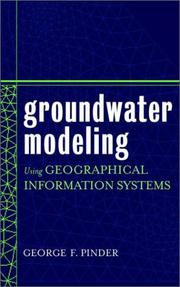
ISBN: 0471084980 Year: 2002 Publisher: New York : John Wiley & Sons,
Abstract | Keywords | Export | Availability | Bookmark
 Loading...
Loading...Choose an application
- Reference Manager
- EndNote
- RefWorks (Direct export to RefWorks)
Cutting-edge techniques for groundwater modeling using GIS technology Groundwater Modeling Using Geographical Information Systems covers fundamental information on flow and mass transport modeling and demonstrates how GIS technology makes these models and analyses more accurate than ever before. GIS technology allows for swift organization, quantification, and interpretation of large quantities of geohydrological data with computer accuracy and minimal risk of human error. This book's companion Web site provides the Princeton Transport Code, as well as the plug-in extensions required to interface this code with the Argus ONE numerical environment software enclosed with this book. Plug-in extensions for MODFLOW and MT3D computer codes can be found at the Argus ONE Web site (www.argusint.com). The process for using the Geographic Modeling Approach (GMA) to model groundwater flow and transport is demonstrated step by step with a field example from Tucson, Arizona. The GMA is composed of the Argus ONE Geographic Information Modeling system and the Princeton Transport Code groundwater flow and transport model, interfaced through the plug-in extension available on Argus ONE. Enhanced with more than 150 illustrations and screen captures, Groundwater Modeling Using Geographical Information Systems is a fundamental book for civil engineers, hydrologists, environmental engineers, geologists, and students in these fields, as well as software engineers working on GIS applications and environmental attorneys and regulators. When used in combination with the free modeling software, this book provides an excellent student text.
556.3 --- Groundwater flow --- -Geographic information systems --- Geographical information systems --- GIS (Information systems) --- Information storage and retrieval systems --- Flow, Groundwater --- Hydraulics --- Fluids --- Subsurface drainage --- Groundwater hydrology. Geohydrology. Hydrogeology --- Mathematical models --- Geography --- Migration --- Geographic information systems. --- Mathematical models. --- 556.3 Groundwater hydrology. Geohydrology. Hydrogeology --- Geographic information systems
Book
Year: 1970 Publisher: Washington (D.C.): Government printing office,
Abstract | Keywords | Export | Availability | Bookmark
 Loading...
Loading...Choose an application
- Reference Manager
- EndNote
- RefWorks (Direct export to RefWorks)
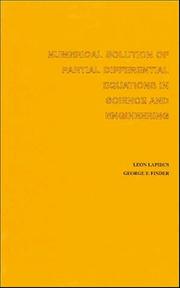
ISBN: 0471098663 9780471098669 Year: 1982 Publisher: New York (N.Y.): Wiley,
Abstract | Keywords | Export | Availability | Bookmark
 Loading...
Loading...Choose an application
- Reference Manager
- EndNote
- RefWorks (Direct export to RefWorks)
From the reviews of Numerical Solution of Partial Differential Equations in Science and Engineering:* "The book by Lapidus and Pinder is a very comprehensive, even exhaustive, survey of the subject . . . [It] is unique in that it covers equally finite difference and finite element methods."-Burrelle's.* "The authors have selected an elementary (but not simplistic) mode of presentation. Many different computational schemes are described in great detail . . . Numerous practical examples and applications are described from beginning to the end, often with calculated results given."-Mathematics of Computing.* "This volume . . . devotes its considerable number of pages to lucid developments of the methods [for solving partial differential equations] . . . the writing is very polished and I found it a pleasure to read!"-Mathematics of ComputationOf related interest . . .NUMERICAL ANALYSIS FOR APPLIED SCIENCE Myron B. Allen and Eli L. Isaacson. A modern, practical look at numerical analysis, this book guides readers through a broad selection of numerical methods, implementation, and basic theoretical results, with an emphasis on methods used in scientific computation involving differential equations. 1997 (0-471-55266-6) 512 pp.APPLIED MATHEMATICS Second Edition, J. David Logan. Presenting an easily accessible treatment of mathematical methods for scientists and engineers, this acclaimed work covers fluid mechanics and calculus of variations as well as more modern methods-dimensional analysis and scaling, nonlinear wave propagation, bifurcation, and singular perturbation. 1996 (0-471-16513-1) 496 pp.
Science --- Engineering mathematics --- Differential equations, Partial --- Mathematics --- Numerical solutions --- 519.63 --- -Engineering mathematics --- -681.3 *G18 --- Natural science --- Science of science --- Sciences --- Engineering --- Engineering analysis --- Mathematical analysis --- Partial differential equations --- Numerical methods for solution of partial differential equations --- Partial differential equations: difference methods; elliptic equations; finite element methods; hyperbolic equations; method of lines; parabolic equations (Numerical analysis) --- Engineering mathematics. --- Numerical solutions. --- Mathematics. --- 681.3 *G18 Partial differential equations: difference methods; elliptic equations; finite element methods; hyperbolic equations; method of lines; parabolic equations (Numerical analysis) --- 519.63 Numerical methods for solution of partial differential equations --- 681.3 *G18 --- Numerical analysis --- Science - Mathematics --- Differential equations, Partial - Numerical solutions --- Analyse numerique --- Equations aux derivees partielles
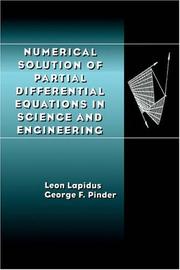
ISBN: 0471359440 9780471359449 Year: 1999 Publisher: New York (N.Y.): Wiley,
Abstract | Keywords | Export | Availability | Bookmark
 Loading...
Loading...Choose an application
- Reference Manager
- EndNote
- RefWorks (Direct export to RefWorks)
Book
ISBN: 9781118087572 Year: 2012 Publisher: Hoboken : John Wiley and Sons,
Abstract | Keywords | Export | Availability | Bookmark
 Loading...
Loading...Choose an application
- Reference Manager
- EndNote
- RefWorks (Direct export to RefWorks)
Mathematical and computational modeling makes it possible to predict the behavior of a broad range of systems across a broad range of disciplines. This text guides students and professionals through the axiomatic approach, a powerful method that will enable them to easily master the principle types of mathematical and computational models used in engineering and science. Readers will discover that this axiomatic approach not only enables them to systematically construct effective models, it also enables them to apply these models to any macroscopic physical system. Mathematical Modeling in Science and Engineering focuses on models in which the processes to be modeled are expressed as systems of partial differential equations. It begins with an introductory discussion of the axiomatic formulation of basic models, setting the foundation for further topics such as: (-) Mechanics of classical and non-classical continuous systems ; (-) Solute transport by a free fluid ; (-) Flow of a fluid in a porous medium ; (-) Multiphase systems ; (-) Enhanced oil recovery ; (-) Fluid mechanics. Throughout the text, diagrams are provided to help readers visualize and better understand complex mathematical concepts. A set of exercises at the end of each chapter enables readers to put their new modeling skills into practice. There is also a bibliography in each chapter to facilitate further investigation of individual topics. Mathematical Modeling in Science and Engineering is ideal for both students and professionals across the many disciplines of science and engineering that depend on mathematical and computational modeling to predict and understand complex systems.
Engineering --- Science --- System analysis --- Mathematical models. --- TECHNOLOGY & ENGINEERING --- Engineering (General) --- Engineering (General). --- Technology & engineering --- Engineering (general).
Book
ISBN: 0471875465 Year: 1983 Publisher: New York (N.Y.) : Wiley,
Abstract | Keywords | Export | Availability | Bookmark
 Loading...
Loading...Choose an application
- Reference Manager
- EndNote
- RefWorks (Direct export to RefWorks)
Numerical analysis --- Partial differential equations --- 519.63 --- Differential equations, Partial --- -Partial differential equations --- Numerical methods for solution of partial differential equations --- Numerical solutions --- Numerical solutions. --- -Numerical methods for solution of partial differential equations --- 519.63 Numerical methods for solution of partial differential equations --- -519.63 Numerical methods for solution of partial differential equations --- Calcul differentiel --- Solution numerique
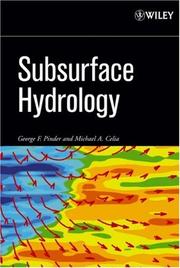
ISBN: 0471742430 9780471742432 Year: 2006 Publisher: Hoboken, N.J. : Wiley-Interscience,
Abstract | Keywords | Export | Availability | Bookmark
 Loading...
Loading...Choose an application
- Reference Manager
- EndNote
- RefWorks (Direct export to RefWorks)
Groundwater. --- Groundwater --- Pollution.
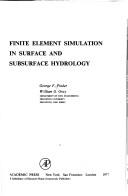
ISBN: 0125569505 Year: 1977 Publisher: New York, NY : Academic Press,
Abstract | Keywords | Export | Availability | Bookmark
 Loading...
Loading...Choose an application
- Reference Manager
- EndNote
- RefWorks (Direct export to RefWorks)
556 --- Finite element method --- Hydrology --- -Hydrology --- -Aquatic sciences --- Earth sciences --- Hydrography --- Water --- FEA (Numerical analysis) --- FEM (Numerical analysis) --- Finite element analysis --- Numerical analysis --- Isogeometric analysis --- Hydrosphere. Water in general. Hydrology --- Data processing --- Mathematical models --- -Hydrosphere. Water in general. Hydrology --- 556 Hydrosphere. Water in general. Hydrology --- -FEA (Numerical analysis) --- GROUND WATER --- MATHEMATICAL MODELS --- FRESH WATER --- Monograph --- Groundwater. --- Mathematical models. --- Fresh water. --- Fresh waters --- Freshwater --- Freshwaters --- Inland water --- Inland waters --- Models, Mathematical --- Simulation methods --- Ground water --- Subterranean water --- Underground water --- Water, Underground --- Hydrogeology --- Éléments finis, Méthode des --- Analyse numérique. --- Hydrologie --- Finite element method. --- Numerical analysis. --- Analyse numérique --- Éléments finis, Méthode des. --- Milieu continu
Book
ISBN: 9780470317624 Year: 2008 Publisher: Hoboken, N.J. : J. Wiley,
Abstract | Keywords | Export | Availability | Bookmark
 Loading...
Loading...Choose an application
- Reference Manager
- EndNote
- RefWorks (Direct export to RefWorks)
Book
ISBN: 0727306014 9780727306012 Year: 1977 Publisher: London : Pentech Press
Abstract | Keywords | Export | Availability | Bookmark
 Loading...
Loading...Choose an application
- Reference Manager
- EndNote
- RefWorks (Direct export to RefWorks)
Hydrology --- Finite element method --- Mathematics --- Natural resources --- Water --- Analysis --- Applications of finite element methods --- Aquatic sciences --- Earth sciences --- Hydrography --- Congresses --- Mathematics&delete&
| Listing 1 - 10 of 17 | << page >> |
Sort by
|

 Search
Search Feedback
Feedback About UniCat
About UniCat  Help
Help News
News